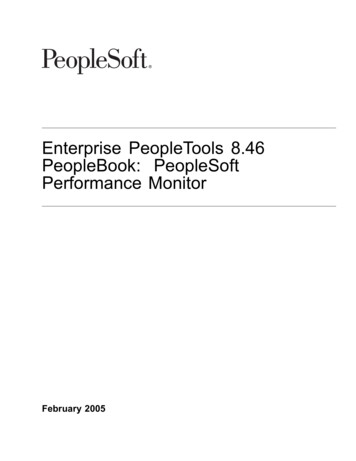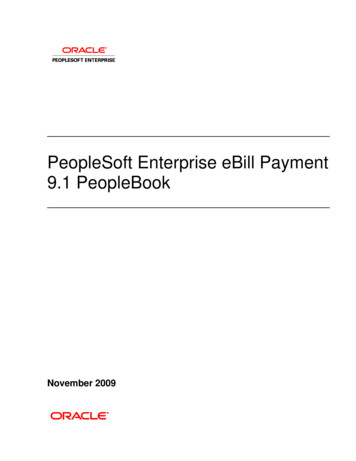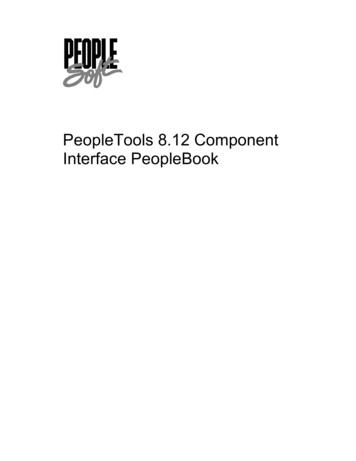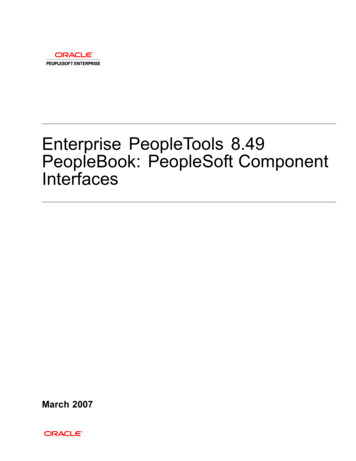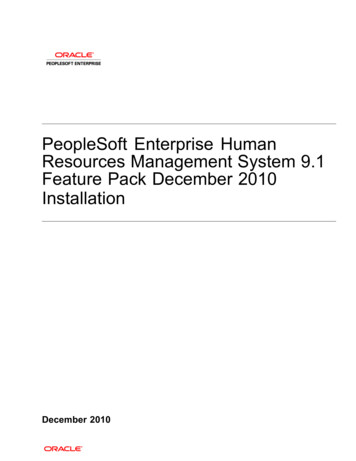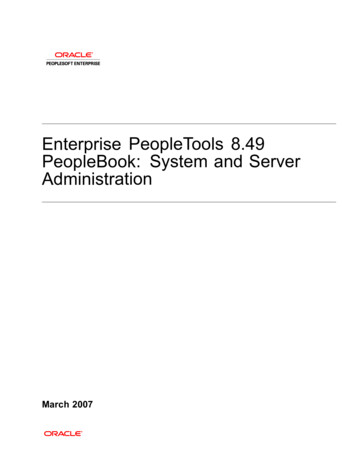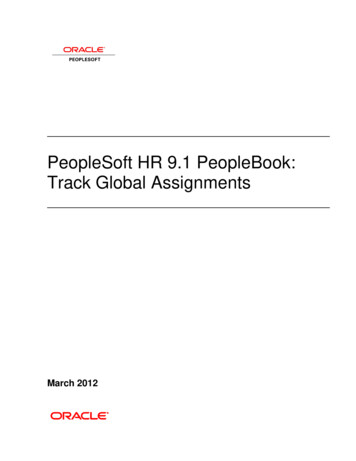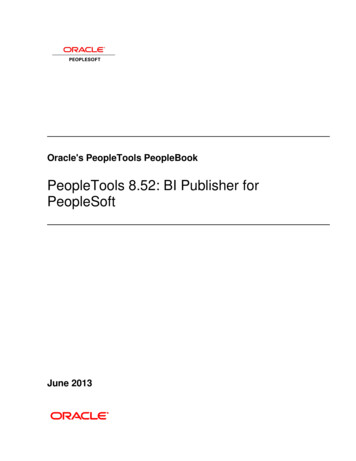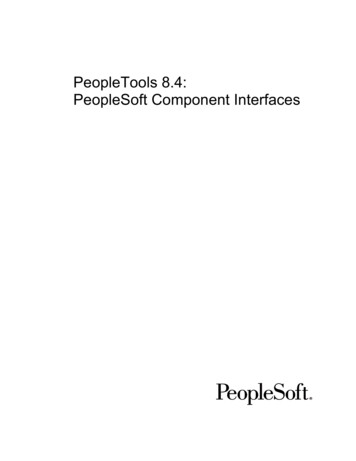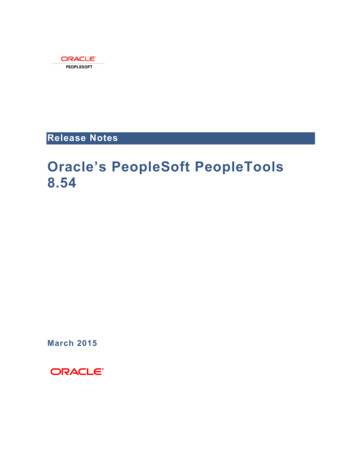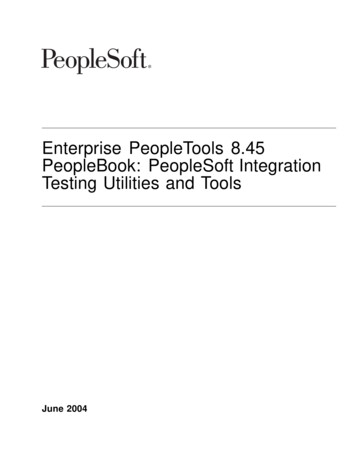
Transcription
Enterprise PeopleTools 8.45PeopleBook: PeopleSoft IntegrationTesting Utilities and ToolsJune 2004
Enterprise PeopleTools 8.45 PeopleBook: PeopleSoft Integration Testing Utilities and ToolsSKU PT845ITU-B 0604Copyright 1988-2004 PeopleSoft, Inc. All rights reserved.All material contained in this documentation is proprietary and confidential to PeopleSoft, Inc. ("PeopleSoft"), protected by copyright laws and subject tothe nondisclosure provisions of the applicable PeopleSoft agreement. No part of this documentation may be reproduced, stored in a retrieval system,or transmitted in any form or by any means, including, but not limited to, electronic, graphic, mechanical, photocopying, recording, or otherwise withoutthe prior written permission of PeopleSoft.This documentation is subject to change without notice, and PeopleSoft does not warrant that the material contained in this documentation is free of errors.Any errors found in this document should be reported to PeopleSoft in writing.The copyrighted software that accompanies this document is licensed for use only in strict accordance with the applicable license agreement which should beread carefully as it governs the terms of use of the software and this document, including the disclosure thereof.PeopleSoft, PeopleTools, PS/nVision, PeopleCode, PeopleBooks, PeopleTalk, and Vantive are registered trademarks, and Pure Internet Architecture,Intelligent Context Manager, and The Real-Time Enterprise are trademarks of PeopleSoft, Inc. All other company and product names may be trademarks oftheir respective owners. The information contained herein is subject to change without notice.Open Source DisclosurePeopleSoft takes no responsibility for its use or distribution of any open source or shareware software or documentation and disclaims any and all liability ordamages resulting from use of said software or documentation. The following open source software may be used in PeopleSoft products and the followingdisclaimers are provided.Apache Software FoundationThis product includes software developed by the Apache Software Foundation (http://www.apache.org/). Copyright (c) 1999-2000 The Apache SoftwareFoundation. All rights reserved.THIS SOFTWARE IS PROVIDED "AS IS" AND ANY EXPRESSED OR IMPLIED WARRANTIES, INCLUDING, BUT NOT LIMITED TO, THEIMPLIED WARRANTIES OF MERCHANTABILITY AND FITNESS FOR A PARTICULAR PURPOSE ARE DISCLAIMED. IN NO EVENT SHALLTHE APACHE SOFTWARE FOUNDATION OR ITS CONTRIBUTORS BE LIABLE FOR ANY DIRECT, INDIRECT, INCIDENTAL, SPECIAL,EXEMPLARY, OR CONSEQUENTIAL DAMAGES (INCLUDING, BUT NOT LIMITED TO, PROCUREMENT OF SUBSTITUTE GOODS ORSERVICES; LOSS OF USE, DATA, OR PROFITS; OR BUSINESS INTERRUPTION) HOWEVER CAUSED AND ON ANY THEORY OF LIABILITY,WHETHER IN CONTRACT, STRICT LIABILITY, OR TORT (INCLUDING NEGLIGENCE OR OTHERWISE) ARISING IN ANY WAY OUT OF THEUSE OF THIS SOFTWARE, EVEN IF ADVISED OF THE POSSIBILITY OF SUCH DAMAGE.OpenSSLCopyright (c) 1998-2003 The OpenSSL Project. All rights reserved.THIS SOFTWARE IS PROVIDED BY THE OpenSSL PROJECT "AS IS" AND ANY EXPRESSED OR IMPLIED WARRANTIES, INCLUDING, BUTNOT LIMITED TO, THE IMPLIED WARRANTIES OF MERCHANTABILITY AND FITNESS FOR A PARTICULAR PURPOSE ARE DISCLAIMED.IN NO EVENT SHALL THE OpenSSL PROJECT OR ITS CONTRIBUTORS BE LIABLE FOR ANY DIRECT, INDIRECT, INCIDENTAL, SPECIAL,EXEMPLARY, OR CONSEQUENTIAL DAMAGES (INCLUDING, BUT NOT LIMITED TO, PROCUREMENT OF SUBSTITUTE GOODS ORSERVICES; LOSS OF USE, DATA, OR PROFITS; OR BUSINESS INTERRUPTION) HOWEVER CAUSED AND ON ANY THEORY OF LIABILITY,WHETHER IN CONTRACT, STRICT LIABILITY, OR TORT (INCLUDING NEGLIGENCE OR OTHERWISE) ARISING IN ANY WAY OUT OF THEUSE OF THIS SOFTWARE, EVEN IF ADVISED OF THE POSSIBILITY OF SUCH DAMAGE.SSLeayCopyright (c) 1995-1998 Eric Young. All rights reserved.THIS SOFTWARE IS PROVIDED BY ERIC YOUNG "AS IS" AND ANY EXPRESS OR IMPLIED WARRANTIES, INCLUDING, BUT NOT LIMITEDTO, THE IMPLIED WARRANTIES OF MERCHANTABILITY AND FITNESS FOR A PARTICULAR PURPOSE ARE DISCLAIMED. IN NOEVENT SHALL THE AUTHOR OR CONTRIBUTORS BE LIABLE FOR ANY DIRECT, INDIRECT, INCIDENTAL, SPECIAL, EXEMPLARY, ORCONSEQUENTIAL DAMAGES (INCLUDING, BUT NOT LIMITED TO, PROCUREMENT OF SUBSTITUTE GOODS OR SERVICES; LOSS OFUSE, DATA, OR PROFITS; OR BUSINESS INTERRUPTION) HOWEVER CAUSED AND ON ANY THEORY OF LIABILITY, WHETHER INCONTRACT, STRICT LIABILITY, OR TORT (INCLUDING NEGLIGENCE OR OTHERWISE) ARISING IN ANY WAY OUT OF THE USE OF THISSOFTWARE, EVEN IF ADVISED OF THE POSSIBILITY OF SUCH DAMAGE.Loki LibraryCopyright (c) 2001 by Andrei Alexandrescu. This code accompanies the book:Alexandrescu, Andrei. "Modern C Design: Generic Programming and Design Patterns Applied". Copyright (c) 2001. Addison-Wesley. Permission to use,copy, modify, distribute and sell this software for any purpose is hereby granted without fee, provided that the above copyright notice appear in all copiesand that both that copyright notice and this permission notice appear in supporting documentation.
ContentsGeneral PrefaceAbout This PeopleBook . . . . . . . . . . . . .ixPeopleSoft Application Prerequisites. . . . . . . . . . . . . .ixPeopleSoft Application Fundamentals. . . . . . . . . .ixRelated Documentation. . . . . . .xObtaining Documentation Updates. . . . . . .xOrdering Printed Documentation. . . . . . . . . . . . .xTypographical Conventions and Visual Cues. . . . . . . . . .xiTypographical Conventions. . . . . . . . . . . . . . . . . .xiVisual Cues. . . .xiiCountry, Region, and Industry Identifiers. . . .xiiCurrency Codes. . . . . . . . .xiiiComments and Suggestions. . . . . . . . .xiiiCommon Elements in These PeopleBooks . . . . . . . . . . . . . . . .xiiiPrefacePeopleSoft Integration Testing Utilities and Tools Preface. . . . . . . . . . . . . . . . . . . . . . . . . .xvIntegration Testing Utilities and Tools. . . . . . . . . .xvChapter 1Getting Started with PeopleSoft Integration Testing Utilities and Tools. . . . . . . . . . . . . . . .1PeopleSoft Integration Testing Utilities and Tools Overview. . . . . . . . .1Implementing PeopleSoft Integration Testing Utilities and Tools. . . . . . . . .2Chapter 2Using the Send Master Utility. . . . . . . . . . . . . . . . . . . . . . .5Understanding Send Master. . . . . . . . . . .5Starting Send Master. . . . . . . . . . . . . . .6Starting Send Master from the Integration Broker SDK. . . . . . . . . . . . . .6Starting the Stand-Alone Version of Send Master. . . . .6Navigating in Send Master. . . . . . . . . .6Using Send Master Menus. . . . . . . . .6Using the Project Workspace. . . . . . . . . .7PeopleSoft Proprietary and Confidentialiii
ContentsUsing the Send Master Batch Workspace. . . . .9Setting Display Preferences. . . . . . . . .12Setting the Display Font, Size and Color. . . . . . . . . . . . .12Setting the Background Color. . . . . . . . .13Setting Word Wrapping Options. . . . . . . . . . . .13Setting HTTP Proxy and Keystore Options. . . . . . . . . . . . . .13Setting Batch Processing Options. . . . . . . . .15Creating Send Master Projects. . . . . . . . . . .15Understanding Send Master Project Types. . . . . . . . . . . . . . .16Creating Send Master Projects. . . . . . . . . . . . . .18Entering Header Information in Send Master Projects. . . . . . . . . . . . . . . . . .19Adding Input Files to Projects. . . . . . . . .20Using Input File Projects. . . . . . . . .21Creating Input File Project Types. . . . . . . . .21Creating and Adding Input Files to Input File Projects. . . . . . . . .21Posting Input File Projects to Web Servers. . . . . . . . . . . . . . . .21Using Integration Broker Projects. . . . . . . . . . . . . .21Understanding Integration Broker Project Types. . . . . . . . . . . . .22Understanding Input Information for Integration Broker Projects. . . . . . . . .22Creating Integration Broker Project Types. . . . . . . . . . . . . . . . . .26Adding PeopleSoft Header Information to Integration Broker Projects. . . . . . . . . . . .26Adding Input Files to Integration Broker Projects. . . . . . . . .26Specifying Connector Information for Integration Broker Projects. . . . . . . . . . . . . . . . . . .26Posting Integration Broker Projects. . . . . . . . . . . . . . .28Viewing Output from Integration Broker Projects. . . . . . . . .28Using EIP Testing Projects. . . . . . . . . .28Creating EIP Testing Project Types. . . . . . . . . . . . . . .28Specifying File Input and File Output Directories. . . . . . . . .28Overriding Requesting and Destination Nodes. . . . . . . . . . . .29Posting EIP Testing Projects. . . . . . . . . . .29Viewing Output from EIP Testing Projects. . . . . . . . .29Using the Batch Project Executor. . . . . . . . . . . . . . . . .29Using MQSeries Projects. . . . . . . . .31Understanding MQSeries Projects. . . . . . . . . . . . .31Understanding Input Information for MQSeries Projects. . . . . . . . . . . . . . .31Creating MQSeries Project Types. . . . . . . . .32Adding Header Information to MQSeries Projects. . . . . . . . . . . . . . . . . . .32Adding Input Files to MQSeries Projects. . . . . . . . . . . . .33Posting MQSeries Projects. . . . . . . . .33Viewing Output from MQSeries Projects. . . . . . . . . . . . . . . .33ivPeopleSoft Proprietary and Confidential
ContentsWorking With Groups of Projects. . . . . . . . .33Creating Groups of Projects. . . . . . . . .33Managing Groups of Projects. . . . . . . . . .34Testing Groups of Projects. . . . . . . . . . . . . . .34Viewing Test Output . . . . . . . . . . . . . .34Sharing Projects and Groups. . . . . . . . . . . . . . .36Using Send Master to Ping Remote Nodes. . . . . . . . . .36Viewing Send Master Processing Performance Statistics. . . . . . . . . . . . . . . . . . .37Enabling the Send Master Statistics Feature. . . . . . . . . . . . . . . .37Accessing Send Master Processing Statistics. . . . . . . . . .37Interpreting Send Master Processing Statistics. . . . . . . . .37Statistics Example. . . . . . . . .38Using Send Master to Export Request Messages. . . . . . . . . . . . . . . . . .39Exporting Request Messages. . . . . . . . .39Allocating Additional Memory to Accommodate Posting Large Files. . . . . . . . . . . . . .39Chapter 3Using the Simple Post Utility . . . . . . . . . . . . . . . . . . . . . . . .41Understanding the Simple Post Utility. . . . . . . . . . . . . . .41Prerequisites. . . . . . . . . . .41Software Requirements. . . . . . . . .41Setting Environment Variables. . . . . . . . .41Accessing the Simple Post Class. . . . . . . . . . . . . . . .42Using the Simple Post Class. . . . . . . . .42Usage. . . . . . . . . . . .42Syntax. . . . . . . . .42Parameters. . . . . . . . . .42Using the Simple Post Utility via a Java API. . . . . . . . .44Constructing a Java File Containing Simple Post Parameters. . . . . . . . . . . . . . . . . . .45Compiling the Java File. . . . . . . . .46Running the Program. . . . . . . . . . . . . . .46Posting Third-Party XML Messages to the Integration Gateway . . . . . . . . . . . . . .47Posting Messages to the Integration Gateway. . . . . . . . . . . . . . . . . . .47Simple Post Submission Examples. . . . . . . . . . . . . . .47Pinging Remote Nodes. . . . . . . . . . .47Increasing the Java Heap Size to Accommodate Posting Large Files. . . . . . . . . . . . . . . . .48Understanding Increasing the Java Heap Size. . . . . . . . . . .48Increasing the Java Heap Size on BEA WebLogic Web Servers. . . . . . . . . . . . . . . . . .48Increasing the Java Heap Size on IBM WebSphere Web Servers. . . . . . . . .49PeopleSoft Proprietary and Confidentialv
ContentsChapter 4Using Automated EIP Testing. . . . . . . . . . . . . . . . . . . . .51Understanding Automated EIP Testing. . . . . . . . . . .51Process Overview. . . . . . . . . . . . . .51Uses for Automated EIP Testing. . . . . . . . .52Understanding Tools Used in Automated EIP Testing. . . . . . . . . . . . .53EIP Data Repository. . . . . . . . .53EIP Gateway Manager. . . . . . . . .54Integration Gateway Properties File. . . . . . . . .54EIP Test Message Properties File. . . . . . . . . . . .55Send Master. . . . . . . . .56Message Export Command Line Tool. . . . . . . . .56Hash Key Generator Command Line Tool. . . . . . . . .58Node Map Properties File. . . . . . . . . . . . . . . .59Recording Messages. . . . . . . . .59Playing Back Messages. . . . . . . . . . . . .60Inbound Playback. . . . . . . . .61Outbound Playback. . . . . . . . . . . . . . . . .61Chapter 5Using the Transformation Test Utility. . . . . . . . . . . . . . . . . . . . . . . . . .63Understanding the Transformation Test Utility. . . . . . . . .63Prerequisites. . . . . . . . . . .63Running the Transformation Test Utility. . . . . . . . . . . . . . . .63Running the Sample Transformation Test Project. . . . . . . . .64Appendix AUsing Send Master to Test Third-Party Messaging and Transform Legacy SystemData. . . . . . . . . . . . . . . . . . . . . . . . . . . . . . . . .67Understanding This Example. . . . . . . . . . . . .67Prerequisites. . . . . . . . . . . . . .67Importing the CSV Transformation Project. . . . . . . . .67Understanding the CSV Transformation Project. . . . . . . . .68Importing the Project. . . . . . . . . . .68Creating Application Database Tables. . . . . . . . . .69Configuring the Transformation. . . . . . . . .69Setting Up Send Master for the Integration. . . . . . . . . . . . . .70Launching the Integration. . . . . . . . . . . . . . .71viPeopleSoft Proprietary and Confidential
ContentsAppendix BISO Country and Currency Codes. . . . . . . . . . . . . .73ISO Country Codes. . . . . . . . . . . . . . . . .73ISO Currency Codes. . . . . . . . .82Glossary of PeopleSoft Terms. . . . . . . . . . . . . . . . . .93Index . . . . . . . . . . . . . . . .109PeopleSoft Proprietary and Confidentialvii
ContentsviiiPeopleSoft Proprietary and Confidential
About This PeopleBookPeopleBooks provide you with the information that you need to implement and use PeopleSoft applications.This preface discusses: PeopleSoft application prerequisites. PeopleSoft application fundamentals. Related documentation. Typographical conventions and visual cues. Comments and suggestions. Common elements in PeopleBooks.Note. PeopleBooks document only page elements that require additional explanation. If a page elementis not documented with the process or task in which it is used, then either it requires no additionalexplanation or it is documented with common elements for the section, chapter, PeopleBook, or productline. Elements that are common to all PeopleSoft applications are defined in this preface.PeopleSoft Application PrerequisitesTo benefit fully from the information that is covered in these books, you should have a basicunderstanding of how to use PeopleSoft applications.See Enterprise PeopleTools 8.45 PeopleBook: Using PeopleSoft Applications.You might also want to complete at least one PeopleSoft introductory training course.You should be familiar with navigating the system and adding, updating, and deleting information byusing PeopleSoft windows, menus, and pages. You should also be comfortable using the World WideWeb and the Microsoft Windows or Windows NT graphical user interface.These books do not review navigation and other basics. They present the information that you needto use the system and implement your PeopleSoft applications most effectively.PeopleSoft Application FundamentalsEach application PeopleBook provides implementation and processing information for your PeopleSoftdatabase. However, additional, essential information describing the setup and design of your systemappears in a companion volume of documentation called the application fundamentals PeopleBook.Each PeopleSoft product line has its own version of this documentation.The application fundamentals PeopleBook consists of important topics that apply to many or allPeopleSoft applications across a product line. Whether you are implementing a single application,some combination of applications within the product line, or the entire product line, you shouldbe familiar with the contents of this central PeopleBook. It is the starting point for fundamentals,such as setting up control tables and administering security.PeopleSoft Proprietary and Confidentialix
General PrefaceRelated DocumentationThis section discusses how to: Obtain documentation updates. Order printed documentation.Obtaining Documentation UpdatesYou can find updates and additional documentation for this release, as well as previous releases,on the PeopleSoft Customer Connection website. Through the Documentation section ofPeopleSoft Customer Connection, you can download files to add to your PeopleBook Library.You’ll find a variety of useful and timely materials, including updates to the full PeopleSoftdocumentation that is delivered on your PeopleBooks CD-ROM.Important! Before you upgrade, you must check PeopleSoft Customer Connection for updates to theupgrade instructions. PeopleSoft continually posts updates as the upgrade process is refined.See AlsoPeopleSoft Customer Connection, ng Printed DocumentationYou can order printed, bound volumes of the complete PeopleSoft documentation that is deliveredon your PeopleBooks CD-ROM. PeopleSoft makes printed documentation available for eachmajor release shortly after the software is shipped. Customers and partners can order printedPeopleSoft documentation by using any of these methods: Web Telephone EmailWebFrom the Documentation section of the PeopleSoft Customer Connection website, access thePeopleBooks Press website under the Ordering PeopleBooks topic. The PeopleBooks Press websiteis a joint venture between PeopleSoft and MMA Partners, the book print vendor. Use a credit card,money order, cashier’s check, or purchase order to place your order.TelephoneContact MMA Partners at 877 588 2525.EmailSend email to MMA Partners at peoplesoftpress@mmapartner.com.See AlsoPeopleSoft Customer Connection, eSoft Proprietary and Confidential
General PrefaceTypographical Conventions and Visual CuesThis section discusses: Typographical conventions. Visual cues. Country, region, and industry identifiers. Currency codes.Typographical ConventionsThis table contains the typographical conventions that are used in PeopleBooks:Typographical Convention or Visual CueDescriptionBoldIndicates PeopleCode function names, method names,language constructs, and PeopleCode reserved words thatmust be included literally in the function call.ItalicsIndicates field values, emphasis, and PeopleSoft or otherbook-length publication titles. In PeopleCode syntax,italic items are placeholders for arguments that yourprogram must supply.We also use italics when we refer to words as words orletters as letters, as in the following: Enter the letter O.KEY KEYIndicates a key combination action. For example, a plussign ( ) between keys means that you must hold downthe first key while you press the second key. For ALT W,hold down the ALT key while you press the W key.Monospace fontIndicates a PeopleCode program or other code example.“ ” (quotation marks)Indicate chapter titles in cross-references and words thatare used differently from their intended meanings. . . (ellipses)Indicate that the preceding item or series can be repeatedany number of times in PeopleCode syntax.{ } (curly braces)Indicate a choice between two options in PeopleCodesyntax. Options are separated by a pipe ( ).PeopleSoft Proprietary and Confidentialxi
General PrefaceTypographical Convention or Visual CueDescription[ ] (square brackets)Indicate optional items in PeopleCode syntax.& (ampersand)When placed before a parameter in PeopleCode syntax,an ampersand indicates that the parameter is an alreadyinstantiated object.Ampersands also precede all PeopleCode variables.Visual CuesPeopleBooks contain the following visual cues.NotesNotes indicate information that you should pay particular attention to as you work with the PeopleSoft system.Note. Example of a note.If the note is preceded by Important!, the note is crucial and includes information that concernswhat you must do for the system to function properly.Important! Example of an important note.WarningsWarnings indicate crucial configuration considerations. Pay close attention to warning messages.Warning! Example of a warning.Cross-ReferencesPeopleBooks provide cross-references either under the heading “See Also” or on a separateline preceded by the word See. Cross-references lead to other documentation that ispertinent to the immediately preceding documentation.Country, Region, and Industry IdentifiersInformation that applies only to a specific
PeopleSoft Integration Testing Utilities and Tools Overview . Using Integration Broker Projects . such as setting up control tables and administering security. PeopleSoft Proprietary and Confidential ix. General Preface Related Documentation This section discusses how to:
